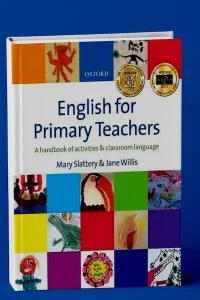English for Primary Teachers is one of the best books that going to help you as a primary teacher and it is available as a PDF and Audio.
English for Primary Teachers (PDF + Audio)
As English is being introduced into primary classrooms around the world, more and more teachers are being asked to teach English to Young Learners. This book was written to help such teachers to improve their spoken English and to use it effectively to help their children learn.
This book is for teachers who teach English to children aged 4-12, including:
- Generalist teachers: i.e. class teachers, who teach all subjects as well as English to one class.
- Specialist language teachers who teach English to several different classes and levels.
- Teachers on training courses (there are lots of _ practical ideas to try out).
- Tutors on a training course for primary teachers of English (in-service or pre-service).
- Teachers who want to study at home (the units are .carefully graded).
The book will help you
- to improve your confidence in speaking English in the classroom
- to broaden your range of language teaching activities.
The adivities and language will be relevant to your classroom because
- The syllabus for the book comes mainly from our ‘bank’ of English lessons recorded and contributed by thirteen different teachers from countries round the world. These lessons are samples of good practice from dedicated and committed teachers – not perfect samples specially prepared, but real classes in action.
- They include a wide range of activities and techniques used by teachers and trainers from different parts of the world and include popular activity types from primary textbooks
- We have selected classroom extracts and examples of language that are typically used by successful non-native primary teachers internationally. Our aim is to provide coverage of classroom English in normal everyday settings – not in idealistic situations.
- The classroom language is carefully graded. Unit 1 begins with basic classroom instructions for a typical lesson. The next units cover specific language relevant to particular activity types. In the final units, we shift the main focus to longer stretches of talk, for example, telling a story.
If you work through the book and CD you will:
- Find many practical ideas to adapt and try out in your lessons.
- Activate the English that you already know and gain the confidence to use more English with your pupils.
- Benefit from other teachers’ experience by hearing typical samples from everyday. English lessons. These are real lessons taught by primary teachers (both non-native and native speakers) around the world, but they have been re-recorded in a studio for this book.
- Expand your range of classroom language. This will help you to:
- Carry out day-to-day classroom organization in English.
- Manage each basic activity type in English.
- Give your children a rich experience of English of different kinds
- From short, simple instructions (for example, Total Physical Response and questions and answers) to longer, sustained talk (for example, storytelling).
- Talk to your learners about topics which interest them, and themes that young learners’ . course books and syllabuses generally cover
- Know when it is helpful to use the children’s mother tongue, and when to allow children to use their mother tongue.
- Be well prepared for future professional development. To summarize, we recognize that teaching English can be more rewarding and less stressful if you
- Feel confident enough to use English as the main language in the classroom during English lessons giving your young learners valuable experience of English in use.
- Have a wide variety of activities that are both fun for young learners and rich in natural language learning opportunities.
This book aims to demonstrate effective language teaching in practice; it rests on sound educational principles and up-to-date theories of child second language acquisition. However, it does not attempt to explain issues in general primary pedagogy or educational psychology.


